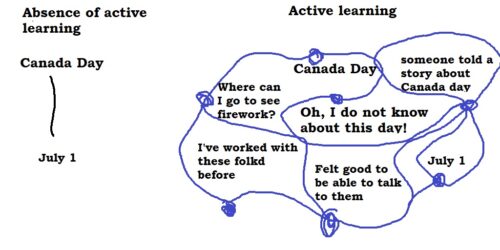
Leveraging Your Slide Deck, Part 1: Scaffolding Assessments for Student Success
A slide deck can be the focus point of a lesson, presenting key information related to the week’s learning outcomes. A slide deck, however, is not simply an overview of content to be presented to students. It is also a treasure trove of opportunities for:
- Scaffolding learning, as you progressively prepare students for evaluations and more complex learning tasks across the semester, and
- Getting students actively involved in their own learning so they are co-constructing knowledge with you in class.
In this Hub post, part 1 of 2, we’ll look at strategies to introduce meaningful opportunities to scaffold learning in an existing slide deck. (Part 2 tackles the active learning piece).
Let’s set the scene: All the slide decks for the semester have been given to you. You are looking at your slide decks for the weeks ahead, and thinking: “How can I start preparing students now for the major assessments in this course?”
Below, we’ll walk through steps you can take to turn slides into activities that support students in preparing for upcoming assessments, offer formative feedback along the way, and guide students in reflecting on their learning after the fact.
Before we get into what happens next, a few notes:
- The activities listed below include options for both in-person and online synchronous delivery. You’ll see options for implementation in each modality along with examples of activities. Note that some online options can also be implemented during in-person teaching, such as Padlet or Mentimeter. Explore this Hub post to explore what active learning does for the brain, and this Hub post for examples of active learning ideas.
- To boost student engagement, these activities are intended to be implemented regularly throughout the teaching period, in quick bursts. Larger activities in a second or third teaching hour are excellent ways of asking students to apply learning, but they don’t preclude offering regular opportunities for students to get involved. The goal is to get students actively involved, as frequently as possible, in their own learning.
Steps you can take . . .
Step 1
Download your slide decks so you can edit them. Looking through your slide decks, identify any existing slides that mention or relate to the upcoming assessment. Look for slides that include assignment instructions, definitions of relevant terms, or concepts that will be important for students to apply in the upcoming assignment. Mark those slides in your slide deck using the highlighter or comment functions. If you are overwhelmed by the number of slides in any given lesson, you can use strategies to manage the amount of information.
Step 2
Determine how often in the coming weeks the assessment is mentioned in the slide decks. Scaffolding for assessments ideally happens in small, frequent increments over several weeks, so note gaps in the slide decks where preparatory activities could be added. Aim to include at least one preparatory activity each week leading up to a major assessment (major means anything weighted at 20% or more of the final course grade).
Step 3
This is the fun part! Choose activities to add to your slides. It’s important here to think small, simple, and scaffolded: activities should be completed during class in a short amount of time (small), with limited preparation for you and your students (simple), and incrementally increase in complexity, with decreasing support provided to students (scaffolded).
For example, let’s say you want to introduce a major assignment that is due at Week 7. It’s Week 3 in your course, and you have one slide that provides an overview of the assignment instructions.
How could you get students involved as you introduce the assignment? Consider these options:
Rubric review
Put students in pairs and have them review the assignment rubric. Task them with identifying one question they have about the evaluation criteria they see on the rubric. Student pairs could each identify one question on a sticky note and place it on the whiteboard (in-person) or post a question to a Padlet or Menti (online).
Ask me anything
Open the floor to questions about the assignment instructions. You can give students five minutes to think before responding. Questions could be collected on the whiteboard (in-person), scraps of paper students anonymously submit (in-person), a Padlet (online), a Menti (online), or in the chat (online).
H5P ordering or matching
Create an H5P activity where students are required to order a set of tasks related to the assignment, or match rubric criteria with their respective levels. The H5P could be embedded on the course shell for completion during class time (in-person and online). Review the completed H5P activity with the whole class to ensure students understand the correct answer.
“Muddiest point”
Ask each student to identify their biggest question or uncertainty about the assignment. This could be submitted as a physical scrap of paper (in-person) or direct message (online) at the end of class, anonymously or not, depending on if you are using the activity to also track attendance.
Step 4
At the beginning of the next class, say as your bridge-in or preassessment in a BOPPPS lesson plan, respond to student contributions or questions from the previous week, when you introduced the assignment. The purpose here is to use what students gave you to further clarify assignment expectations, while also showing students that you listen to their feedback and that their peers have similar questions. Sharing back in this way can validate learning as it happens.
You can:
- Verbally and on a slide, highlight themes from questions students asked about the assignment. Do this generally and anonymously. No one student should be called out in this process.
- Validate questions and provide further clarification as necessary.
Step 5
In each subsequent week leading up to the deadline, design short activities that build students’ capacity and confidence to complete the upcoming assessment. Use the following checklist of considerations as a guide in planning activities.
Checklist of considerations
Activities should:
- Continue to respond to student questions and concerns around the assignment.
- Reinforce weekly content.
- Ask students to practice the same tasks, skills, or competencies they will be assessed on, but in miniature or condensed form, and with peer and instructor support.
- Become increasingly complex and independent.
- Be accompanied by concise but meaningful formative feedback so students can adjust learning strategies appropriately. Examples of formative feedback include verbally debriefing an activity, identifying trends in student questions, taking up the results of a Menti multiple choice quiz or Zoom poll, or reviewing a checklist of tasks.
- Offer students opportunities to develop self-awareness as learners by reflecting on learning challenges and successes.
Let’s identify specific slides where you can include relevant activities.
Review your slides for the following:
| The slide includes | Turn it into an activity |
| Definitions of terms | Students craft rough definitions using the Internet or other permitted aids; you guide their responses and add material they might miss. |
| Frameworks, processes, timelines | Students draft and order the components in small groups; you fill in details and course correct. |
| Descriptions of roles, duties, or positions | Students brainstorm and draft descriptions first in pairs, then by joining another pair to collect ideas in a team of four; in debriefing with the whole class, you offer additional input. |
| Diagrams, charts, images | Students collectively annotate or label on a shared document; you offer suggestions and provide feedback. |
| Equations | Students solve sample equations in teams and present their results in a shared document; you compare their answers to a key. |
| Discussion questions | Students craft an initial response in a think-pair-share, then summarize their key points on a piece of poster paper or a Padlet; you verbally review their responses and offer feedback. |
| Scenarios | Students analyze a mini-scenario, related to the week’s topic, in small groups and present their findings to the rest of the class in a two-minute verbal summary; you collect a list of common themes on the whiteboard or a shared document. |
Step 6
The week before the assessment is due, ensure you provide time for review of expectations and any last-minute clarification, as well as a check-in on progress in completing the assessment.
Turn a reminder slide of the upcoming deadline into an activity by having students:
- Engage in an ungraded peer review activity, looking at each other’s draft work and using the rubric to offer supportive feedback.
- Conduct a self-assessment, where students grade their own work according to rubric criteria and identify remaining tasks to be accomplished.
- Compile a collection of outstanding questions about the assessment and its submission procedure. Anonymity is ideal for this activity to get the broadest sample of questions, so consider a Padlet or Menti (friendly for both in-person and online).






